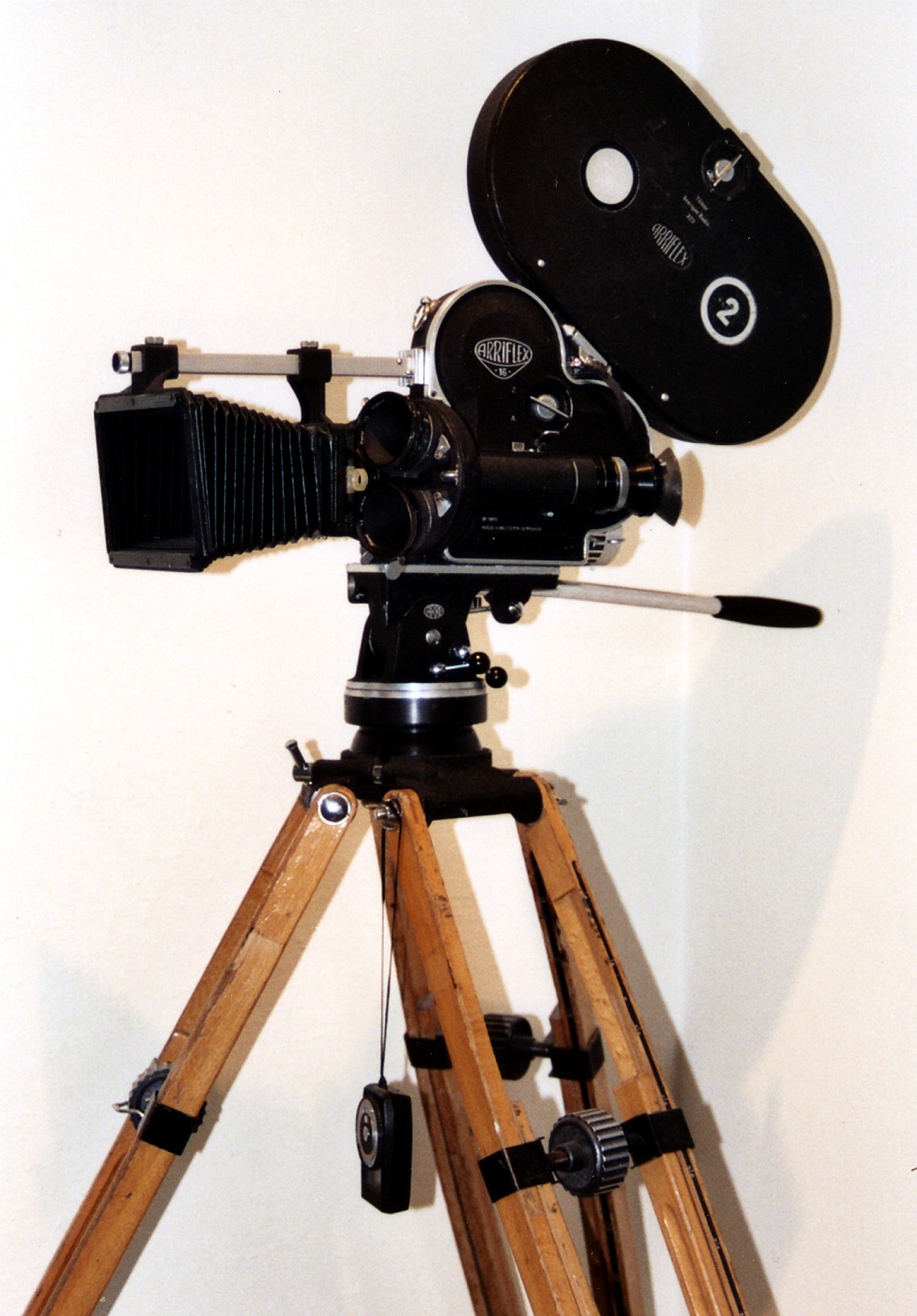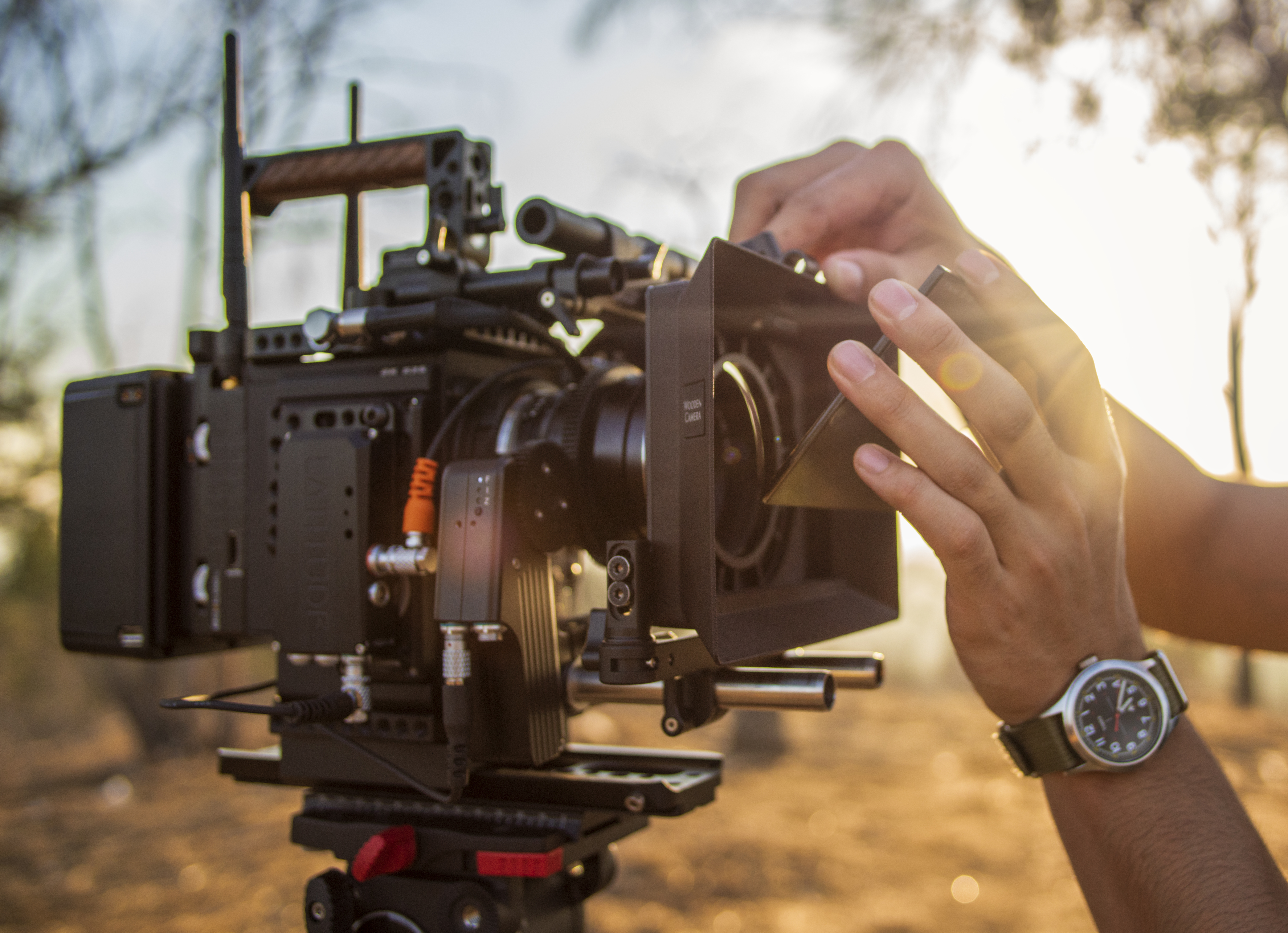|
Arriflex 16ST
The Arriflex 16ST, also Arriflex 16S, is a 16mm MOS production motion picture camera released in 1952 by ARRI. The camera utilizes a voltage of 8.4 volts DC Function Like earlier models, the ARRI 16ST was built around the spinning reflex twin-bladed "butterfly" mirror shutter designed by Erich Kästner, chief engineer at Arnold & Richter Cine Technik (ARRI), Arri Group, set at 45 degrees horizontally to the lens axis. It uses a 3-lens turret with ARRI standard mounts. The viewfinder In photography, a viewfinder is what the photographer looks through to compose, and, in many cases, to focus the picture. Most viewfinders are separate, and suffer parallax, while the single-lens reflex camera lets the viewfinder use the main ... is located on the gate door. The design is very similar to the Arriflex 35. The Arriflex 16ST can load 100ft daylight spools internally and a 400ft external magazine can be attached to the top. The camera is driven by a 12V crystal control motor, wh ... [...More Info...] [...Related Items...] OR: [Wikipedia] [Google] [Baidu] |
ARRI 16 ST Stativ, 1
The Arri Group () is a German manufacturer of motion picture film equipment. Based in Munich, the company was founded in 1917. It produces professional motion picture cameras, lenses, lighting and post-production equipment. Hermann Simon mentioned this company in his book ''Hidden Champions of the 21st Century'' as an example of a " hidden champion". The Arri Alexa camera system was used to film Academy Award winners for Best Cinematography including '' Hugo'', '' Life of Pi'', ''Gravity'', '' Birdman'', '' The Revenant'' and ''1917''. History Early history Arri was founded in Munich, Germany on 12 September 1917 by August Arnold and Robert Richter as Arnold & Richter Cine Technik. The acronym ''Arri'' was derived from the initial two letters of the founders' surnames, ''Ar''nold and ''Ri''chter. In 1924, Arnold and Richter developed their first film camera, the small and portable Kinarri 35. In 1937, Arri introduced the world's first reflex mirror shutter in the Arriflex 35 ... [...More Info...] [...Related Items...] OR: [Wikipedia] [Google] [Baidu] |
16mm Film
16 mm film is a historically popular and economical gauge of film. 16 mm refers to the width of the film (about inch); other common film gauges include 8 and 35 mm. It is generally used for non-theatrical (e.g., industrial, educational, televisual) film-making, or for low-budget motion pictures. It also existed as a popular amateur or home movie-making format for several decades, alongside 8 mm film and later Super 8 film. Eastman Kodak released the first 16 mm "outfit" in 1923, consisting of a camera, projector, tripod, screen and splicer, for US$335 (). RCA-Victor introduced a 16 mm sound movie projector in 1932, and developed an optical sound-on-film 16 mm camera, released in 1935. History Eastman Kodak introduced 16 mm film in 1923, as a less expensive alternative to 35 mm film for amateurs. The same year the Victor Animatograph Corporation started producing their own 16 mm cameras and projectors. During the 1920s, th ... [...More Info...] [...Related Items...] OR: [Wikipedia] [Google] [Baidu] |
Motion Picture Camera
A movie camera (also known as a film camera and cine-camera) is a type of photographic camera that rapidly takes a sequence of photographs, either on an image sensor or onto film stock, in order to produce a moving image to project onto a movie screen. In contrast to the still camera, which captures a single image at a time, by way of an intermittent mechanism, the movie camera takes a series of images; each image is a ''frame'' of film. The strips of frames are projected through a movie projector at a specific frame rate (number of frames per second) to show a moving picture. When projected at a given frame rate, the persistence of vision allows the eyes and brain of the viewer to merge the separate frames into a continuous moving picture. History An interesting forerunner to the movie camera was the machine invented by Francis Ronalds at the Kew Observatory in 1845. A photosensitive surface was drawn slowly past the aperture diaphragm of the camera by a clockwork mechanism ... [...More Info...] [...Related Items...] OR: [Wikipedia] [Google] [Baidu] |
ARRI
The Arri Group () is a German manufacturer of motion picture film equipment. Based in Munich, the company was founded in 1917. It produces professional motion picture cameras, lenses, lighting and post-production equipment. Hermann Simon mentioned this company in his book ''Hidden Champions of the 21st Century'' as an example of a " hidden champion". The Arri Alexa camera system was used to film Academy Award winners for Best Cinematography including '' Hugo'', '' Life of Pi'', ''Gravity'', '' Birdman'', '' The Revenant'' and '' 1917''. History Early history Arri was founded in Munich, Germany on 12 September 1917 by August Arnold and Robert Richter as Arnold & Richter Cine Technik. The acronym ''Arri'' was derived from the initial two letters of the founders' surnames, ''Ar''nold and ''Ri''chter. In 1924, Arnold and Richter developed their first film camera, the small and portable Kinarri 35. In 1937, Arri introduced the world's first reflex mirror shutter in the Arriflex ... [...More Info...] [...Related Items...] OR: [Wikipedia] [Google] [Baidu] |
ARRI 16 ST
The Arri Group () is a German manufacturer of motion picture film equipment. Based in Munich, the company was founded in 1917. It produces professional motion picture cameras, lenses, lighting and post-production equipment. Hermann Simon mentioned this company in his book ''Hidden Champions of the 21st Century'' as an example of a " hidden champion". The Arri Alexa camera system was used to film Academy Award winners for Best Cinematography including ''Hugo'', ''Life of Pi'', ''Gravity'', '' Birdman'', '' The Revenant'' and ''1917''. History Early history Arri was founded in Munich, Germany on 12 September 1917 by August Arnold and Robert Richter as Arnold & Richter Cine Technik. The acronym ''Arri'' was derived from the initial two letters of the founders' surnames, ''Ar''nold and ''Ri''chter. In 1924, Arnold and Richter developed their first film camera, the small and portable Kinarri 35. In 1937, Arri introduced the world's first reflex mirror shutter in the Arriflex 35 c ... [...More Info...] [...Related Items...] OR: [Wikipedia] [Google] [Baidu] |
Erich Kästner (camera Designer)
Erich Kurt Kästner (5 April 1911 – 31 January 2005) was a German movie camera designer. He was born in Jena. During his work for ARRI, he invented the spinning mirror reflex shutter for film cameras, which was first used in the Arriflex 35 in 1937. It allows the operator to have a viewfinder image equal to the recorded picture. Kästner received a Gordon E. Sawyer Award in 1992 and an Oscar in 1973 (Class II technical award laque and 1982 (Academy Award of Merit tatuette. In 1994 he won the Bavarian Film Awards The Bavarian Film Awards (german: Bayerischer Filmpreis) have been awarded annually since 1979 by the state government of Bavaria in Germany for “exceptional achievement in German filmmaking.” Along with the German Film Awards, these are th ... Honorary Award He died in Penzberg. References 1911 births 2005 deaths Academy Award for Technical Achievement winners Cinema pioneers 20th-century German inventors Scientists from Jena People from Saxe-W ... [...More Info...] [...Related Items...] OR: [Wikipedia] [Google] [Baidu] |
Viewfinder
In photography, a viewfinder is what the photographer looks through to compose, and, in many cases, to focus the picture. Most viewfinders are separate, and suffer parallax, while the single-lens reflex camera lets the viewfinder use the main optical system. Viewfinders are used in many cameras of different types: still and movie, film, analog and digital. A zoom camera usually zooms its finder in sync with its lens, one exception being rangefinder cameras. History Before the development of microelectronics and electronic display devices, only optical viewfinders existed. Direct optical viewfinders Direct viewfinders are essentially miniature Galilean telescopes; the viewer's eye was placed at the back, and the scene viewed through the viewfinder optics. A declining minority of point and shoot cameras use them. Parallax error results from the viewfinder being offset from the lens axis, to point above and usually to one side of the lens. The error varies with distance, be ... [...More Info...] [...Related Items...] OR: [Wikipedia] [Google] [Baidu] |
Arriflex 35
The Arriflex 35, released by Arri in 1937, was the first reflex 35mm production motion picture camera. Function It was built around the spinning reflex twin-bladed "butterfly" mirror shutter designed by Erich Kästner, chief engineer at Arnold & Richter Cine Technik (ARRI), Arri Group, set at 45 degrees horizontally to the lens axis. This mirror reflex system was invented in 1931. Modern standard models have a maximum shutter exposure opening of 165 degrees, (not 180 degrees as claimed in Arri manuals), the 35 IIC-BV model having a variable shutter. The mirror shutter allows the camera operator to see a viewfinder image equal to the recorded picture, without parallax, although there is noticeable image flicker in the viewfinder when the camera is running, caused by the two open exposure segments of the mirror shutter. The camera utilizes a three lens turret with three aluminum Arri lens mounts (later 35 IIC/B with one stainless steel bayonet mount and two aluminum Arri mounts), ... [...More Info...] [...Related Items...] OR: [Wikipedia] [Google] [Baidu] |
Matte Box
In photography and videography, a matte box is a device attached to the end of a lens in order to prevent light leakage. It performs and mounts essentially the same as a lens hood, but usually includes adjustable fins called ''French flags''. Another purpose of a matte box is to hold filters in place in front of the lens. Some are supported by two rods that run the length of the camera, while others are supported by the lens itself. A matte box may have a bellows, a rigid sunshade, or both. If both, the bellows is positioned within the rigid sunshade, having a mask which may be adjusted forward or backward to suit the angle of view of the camera system. See also * Barn doors – stage lights * Lens hood – still camera Further reading * to Roger C. Field Roger C. Field (born 31 July 1945) is best known as the inventor of the Foldaxe folding electric guitar which won the Designers' Choice Award for the United States in 1980. He is also an inventor with over 100 patent ... [...More Info...] [...Related Items...] OR: [Wikipedia] [Google] [Baidu] |




.jpg)
